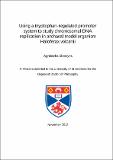Files in this item
Using a tryptophan-regulated promoter system to study chromosal DNA replication in archaeal model organism Haloferax volcanii
Item metadata
| dc.contributor.advisor | MacNeill, Stuart | |
| dc.contributor.author | Skowyra, Agnieszka | |
| dc.coverage.spatial | xiv, 191 | en_US |
| dc.date.accessioned | 2013-06-07T08:54:39Z | |
| dc.date.available | 2013-06-07T08:54:39Z | |
| dc.date.issued | 2013 | |
| dc.identifier | uk.bl.ethos.574823 | |
| dc.identifier.uri | https://hdl.handle.net/10023/3620 | |
| dc.description.abstract | Chromosomal DNA replication is an essential process for all forms of cellular life. Archaea, the third domain of life, possess a DNA replication apparatus that shares significant protein sequence similarity with eukaryotic replication factors, making the Archaea a good model system for understanding the biology of chromosome replication in Eukaryotes. The results described in this thesis contribute to the genetic and physiological characterisation of DNA replication in the model organism Haloferax volcanii, a halophilic euryarchaeon. The thesis documents the generation of conditional lethal mutants of replication genes in H.volcanii using the tryptophan- regulated tna promoter and its TATA-box mutant, tnaM3. This system was used to study the cellular function of the triple OB fold containing single-stranded DNA binding protein RpaC and for characterisation of PriS-GINS operon. Deletion analysis of three putative SSB proteins in H.volcanii indicated that RpaA1 and RpaB1 are individually non-essential for cell viability but share an essential function, whereas RpaC protein is essential. Loss of RpaC function can however be rescued by elevated expression of RpaB, indicative of functional overlap between the two classes of haloarchaeal SSB. Down-regulation of RpaC caused growth retardation and a significant reduction of DNA synthesis in vivo suggesting, that RpaC is required for DNA replication. In addition, RpaC overexpression increased resistance to various types of DNA damage implying its role in DNA repair. This function is probably mediated by the N-terminus as deletion of this region makes cells sensitive to DNA damaging agents. Analyses of PriS-GINS operon indicated that GINS could be down-regulated without severe consequences for the cells suggesting that it is non-essential protein in H.volcanii. In addition, bioinformatics studies identified sequence similarity between the C-terminal domain of the catalytic subunit of archaeal primase (PriS CTD) and B-domain of GINS51 and B-domain of GINS23 that offer insights into mechanisms for the evolution of these proteins. | en_US |
| dc.language.iso | en | en_US |
| dc.publisher | University of St Andrews | |
| dc.subject.lcc | QR82.A69S6 | |
| dc.subject.lcsh | Halobacterium--Molecular genetics | en_US |
| dc.subject.lcsh | Chromosome replication | en_US |
| dc.subject.lcsh | Promoters (Genetics) | en_US |
| dc.subject.lcsh | DNA-binding proteins | en_US |
| dc.title | Using a tryptophan-regulated promoter system to study chromosal DNA replication in archaeal model organism Haloferax volcanii | en_US |
| dc.type | Thesis | en_US |
| dc.accrualMethod | DNA-binding proteins | en_US |
| dc.type.qualificationlevel | Doctoral | en_US |
| dc.type.qualificationname | PhD Doctor of Philosophy | en_US |
| dc.publisher.institution | The University of St Andrews | en_US |
This item appears in the following Collection(s)
Items in the St Andrews Research Repository are protected by copyright, with all rights reserved, unless otherwise indicated.

